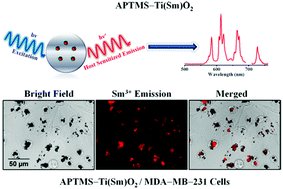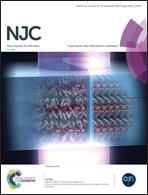Host-sensitized sharp samarium emission from doped titanium dioxide nanoparticles as non-cytotoxic photostable reporters for live-cell imaging†
Abstract
Lanthanide-incorporated semiconductor nanoparticle luminophores are attractive alternatives to conventional organic fluorophores for live-cell imaging due to their non-overlapping sharp emission bands, longer luminescence lifetimes and resistance to photobleaching. These materials provide avenues to use the unique luminescence properties of lanthanides, allowing the incorporation of multiple luminophores into the host matrix generating an enhanced emission, with additional benefits from the surface functionalization of the nanoparticles. Here, we report the first demonstration of host-sensitized samarium (Sm3+) emission, from (3-aminopropyl)trimethoxysilane (APTMS) functionalized Sm3+ doped titanium dioxide [Ti(Sm)O2] nanoparticles, and its usefulness as a live-cell imaging probe in human mammary adenocarcinoma (MDA-MB-231) and human embryonic kidney (HEK 293T) cell lines. Photoluminescence spectroscopic experiments with the lysates, obtained from cells treated with APTMS-Ti(Sm)O2 nanoparticles, displaying the host-sensitized sharp samarium (Sm3+) emission and the images acquired from both the bright field and emission channels in epifluorescence microscopy experiments of nanoparticle treated cells clearly indicate the interaction of the nanoparticles with the cells and their effectiveness as an imaging probe. Additionally, the non-cytotoxicity and photostability of this probe provide further benefits in the context of (i) increasing the probe concentration without compromising cellular viability and (ii) longer experimental times without encountering photobleaching, thus essentially improving the signal-to-noise ratio; challenges that are often associated with organic moiety based imaging probes.



 Please wait while we load your content...
Please wait while we load your content...